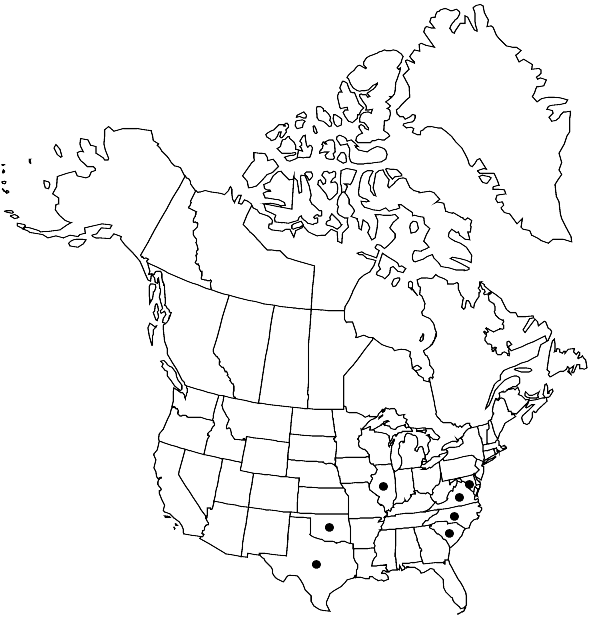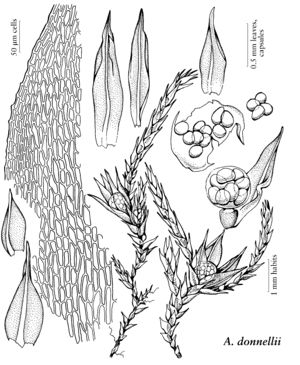Archidium donnellii
Bull. Torrey Bot. Club 6: 190. 1877,.
Plants 2–10 mm, perennial, in dense turfs, yellow-green. Stems simple or usually branched by several sterile innovations, becoming prostrate with age. Stem-leaves erect to erect-spreading, lanceolate to narrowly ovatelanceolate, acuminate, 1–2.5 mm; costa percurrent or short-excurrent, sometimes somewhat subulate; laminal margins recurved, smooth or finely serrulate distally; median and distal laminal cells irregular in shape, mixed quadrate, trapezoidal, short-rectangular, short to long-rhomboidal, 14–75 × 8–13 µm, proximal cells quadrate to short-rectangular, similar to median and distal cells; leaves of innovations similar to stem-leaves, not much reduced proximally. Perichaetial leaves broadly ovatelanceolate, narrowly acuminate to subulate, sometimes flexuose to secund, same size as stem-leaves; costae short to long excurrent, hairpoint pellucid, sometimes finely spinose; laminal margins recurved, smooth to finely serrulate; distal and median laminal cells similar to stem-leaves, proximal laminal cells lax, wider, rectangular, 2–4: 1, 35–115 × 12–25 µm, sometimes somewhat hyaline. Specialized asexual gemmae absent. Sexual condition autoicous; antheridia terminating axillary leaf buds. Capsule terminal, 425–750 µm. Spores typically 28 (4–60) per capsule, angular to irregularly polyhedral, 120–230 µm, smooth or finely granulose, yellow to orange-red.
Phenology: Capsules mature early spring (Mar), more rarely in autumn or winter (Oct–Dec).
Habitat: Uncommon on moist to dry soil along roadsides, in fields, rarely on rock
Elevation: 0-250 m
Distribution

Ill., Md., Okla., N.C., S.C., Tex., Va., Mexico
Discussion
Archidium donnellii usually can be distinguished from other species by irregular areolation in median and distal portions of lamina, proximal lamina cells not strongly differentiated, and sexuality autoicous. It tends to grow in drier habitats than do other species of the genus.
Selected References
None.
Lower Taxa
"um" is not declared as a valid unit of measurement for this property.
